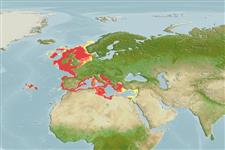Bivalvia |
Ostreida |
Pinnidae
Environment: milieu / climate zone / εύρος βάθους / distribution range
Οικολογία
; εύρος βάθους 0 - 600 m (Αναφ. 116804). Temperate
Northeast Atlantic and the Mediterranean Sea: UK.
Length at first maturity / Μέγεθος / Weight / Age
Γεννητική Ωρίμανση: Lm ? range ? - ? cm
Life cycle and mating behavior
Γεννητική Ωρίμανση | Αναπαραγωγή | Γεννοβολία | Eggs | Γονιμότητα | Larvae
Members of the class Bivalvia are mostly gonochoric, some are protandric hermaphrodites. Life cycle: Embryos develop into free-swimming trocophore larvae, succeeded by the bivalve veliger, resembling a miniature clam.
Hayward, P.J. and J.S. Ryland (eds.) 1990 The marine fauna of the British Isles and North-West Europe: 1. Introduction and protozoans to arthropods. Clarendon Press: Oxford, UK. 627 pp. (Αναφ. 3553)
IUCN Red List Status
(Αναφ. 130435: Version 2025-1)
CITES status (Αναφ. 108899)
Not Evaluated
Not Evaluated
Threat to humans
Human uses
| FishSource |
Εργαλεία
Περισσότερες πληροφορίες
Τροφική ΟικολογίαFood items (preys)
Σύσταση δίαιτας
Κατανάλωση τροφής
Θηρευτές
Population dynamicsΑύξησηMax. ages / sizesLength-weight rel.Length-length rel.Length-frequenciesMass conversionΑφθονία Life cycleΑναπαραγωγήΓεννητική ΩρίμανσηΓονιμότηταΓεννοβολίαEggsEgg developmentLarvae PhysiologyΚατανάλωση οξυγόνου
Human RelatedStamps, coins, misc.
Διαδικτυακές πηγές
Estimates based on models
Price category
Unknown.
